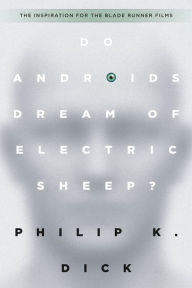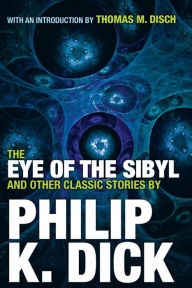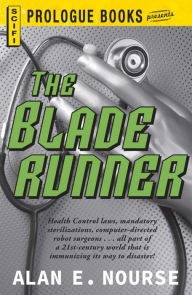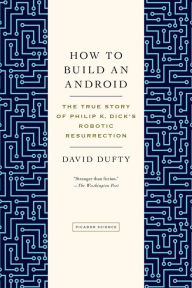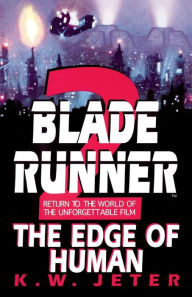10 Things You Might Not Know About Philip K. Dick, Blade Runner, & Do Androids Dream of Electric Sheep?
Do Androids Dream of Electric Sheep? (Blade Runner)
Do Androids Dream of Electric Sheep? (Blade Runner)
By
Philip K. Dick
Introduction
Roger Zelazny
In Stock Online
Paperback $16.00
In modern times it seems as if Blade Runner has always existed, along with the rainy, sepia-toned cyberpunk aesthetic it defined. The 1982 film is often used as shorthand to convey a certain tone and look: societal and environmental collapse coupled with technology run amok. The film and the Philip K. Dick novel that inspired it (Do Androids Dream of Electric Sheep) are possibly the most analyzed and reviewed works of science fiction in history—and yet we’re willing to bet you don’t know everything about them. As we looking forward to the further adventures of Rick Deckard in the forthcoming sequel, directed by Denis Villeneuve (Arrival), here are ten things you might not know about the book and the film.
In modern times it seems as if Blade Runner has always existed, along with the rainy, sepia-toned cyberpunk aesthetic it defined. The 1982 film is often used as shorthand to convey a certain tone and look: societal and environmental collapse coupled with technology run amok. The film and the Philip K. Dick novel that inspired it (Do Androids Dream of Electric Sheep) are possibly the most analyzed and reviewed works of science fiction in history—and yet we’re willing to bet you don’t know everything about them. As we looking forward to the further adventures of Rick Deckard in the forthcoming sequel, directed by Denis Villeneuve (Arrival), here are ten things you might not know about the book and the film.
The Eye of the Sibyl and Other Classic Stories
The Eye of the Sibyl and Other Classic Stories
Paperback
$10.98
$16.00
Dick played with the same concepts in an early short story.
The film and the novel differ in a lot of ways. One of the significant aspects of the book missing from the film is Dick’s concept of Mercerism, the pseudo-religion involving a man named Wilbur Mercer, and mysterious “empathy boxes” that allow anyone who uses them to experience Mercer’s existence simultaneously with everyone else in the universe. Mercerism is a big part of Androids, and it’s a concept Dick first explored four years earlier, in a 1964 short story called The Little Black Box, which could be seen as being set in the same universe, only possibly decades—or more—earlier, before the nuclear holocaust that completely reshaped the world.
In the book, Pris and Rachel are the same model.
The film is stuffed with iconic visuals, from its dreary vision of future Los Angeles to the striking appearance of the replicants. In the film, Pris and Rachel are strikingly different, especially after Pris’ spray-paint makeup job, but in the novel they’re the same model of replicant—and thus look exactly alike, to the point Pris can impersonate Rachel.
The film characters have animal familiars …
An animal motif is applied to all of the characters in the movie, with each receiving a familiar that conveys something of their personality. Deckard’s, of course, is the unicorn. Roy is associated with wolves (he howls like one). Rachel has an implanted memory about spiders. Pris resembles a raccoon after her spray-paint experiments. Dr. Tyrell has an Owl in his office, and his huge glasses make him resemble one.
… and this is thematically significant in the novel.
Animals play a major symbolic role in the novel, where it’s explicit that, after the nuclear war that left the Earth broken and drove most of the population to off-planet colonies, humanity regarded the remaining animals as sacred. Caring for an animal becomes a socially-mandated requirement, to the point where people who can’t afford to care for a real animal purchase replicant animals.
Dick played with the same concepts in an early short story.
The film and the novel differ in a lot of ways. One of the significant aspects of the book missing from the film is Dick’s concept of Mercerism, the pseudo-religion involving a man named Wilbur Mercer, and mysterious “empathy boxes” that allow anyone who uses them to experience Mercer’s existence simultaneously with everyone else in the universe. Mercerism is a big part of Androids, and it’s a concept Dick first explored four years earlier, in a 1964 short story called The Little Black Box, which could be seen as being set in the same universe, only possibly decades—or more—earlier, before the nuclear holocaust that completely reshaped the world.
In the book, Pris and Rachel are the same model.
The film is stuffed with iconic visuals, from its dreary vision of future Los Angeles to the striking appearance of the replicants. In the film, Pris and Rachel are strikingly different, especially after Pris’ spray-paint makeup job, but in the novel they’re the same model of replicant—and thus look exactly alike, to the point Pris can impersonate Rachel.
The film characters have animal familiars …
An animal motif is applied to all of the characters in the movie, with each receiving a familiar that conveys something of their personality. Deckard’s, of course, is the unicorn. Roy is associated with wolves (he howls like one). Rachel has an implanted memory about spiders. Pris resembles a raccoon after her spray-paint experiments. Dr. Tyrell has an Owl in his office, and his huge glasses make him resemble one.
… and this is thematically significant in the novel.
Animals play a major symbolic role in the novel, where it’s explicit that, after the nuclear war that left the Earth broken and drove most of the population to off-planet colonies, humanity regarded the remaining animals as sacred. Caring for an animal becomes a socially-mandated requirement, to the point where people who can’t afford to care for a real animal purchase replicant animals.
The Bladerunner
The Bladerunner
By Jeff Price
In Stock Online
eBook $3.99
The phrase “Blade Runner” never appears in the book.
The development of Androids into the film was kind of twisty, with director Ridley Scott initially afraid he would be typecast as a sci-fi filmmaker (heaven forbid), star Harrison Ford miserable on set, and funding being lost just a few weeks before the shoot was to begin. When Scott finally committed to the project, the first thing he noted was that the story needed a better term to describe Deckard than simply “detective,” which he thought lazy writing. His team came across a story by Alan E. Nourse called The Bladerunner that had been adapted into a treatment by none other than William S. Burroughs. Scott licensed just the title from Burroughs.
The phrase “Blade Runner” never appears in the book.
The development of Androids into the film was kind of twisty, with director Ridley Scott initially afraid he would be typecast as a sci-fi filmmaker (heaven forbid), star Harrison Ford miserable on set, and funding being lost just a few weeks before the shoot was to begin. When Scott finally committed to the project, the first thing he noted was that the story needed a better term to describe Deckard than simply “detective,” which he thought lazy writing. His team came across a story by Alan E. Nourse called The Bladerunner that had been adapted into a treatment by none other than William S. Burroughs. Scott licensed just the title from Burroughs.
How to Build an Android: The True Story of Philip K. Dick's Robotic Resurrection
How to Build an Android: The True Story of Philip K. Dick's Robotic Resurrection
In Stock Online
eBook $7.99
Philip K. Dick was an android
In 2005, a team of roboticists at the University of Memphis began a project to create a lifelike android, and they chose Philip K. Dick as their template (for obvious reasons). The android, named “Phil,” was made to resemble Dick physically and to mimic his speech patterns. In 2006, David Hanson, one of the leads on the project, took the head on a plane—and lost it. It has never been recovered. You can read this fascinating story about artificial intelligence and the android Phil in David Dufty’s book, How to Build an Android.
Philip K. Dick was an android
In 2005, a team of roboticists at the University of Memphis began a project to create a lifelike android, and they chose Philip K. Dick as their template (for obvious reasons). The android, named “Phil,” was made to resemble Dick physically and to mimic his speech patterns. In 2006, David Hanson, one of the leads on the project, took the head on a plane—and lost it. It has never been recovered. You can read this fascinating story about artificial intelligence and the android Phil in David Dufty’s book, How to Build an Android.
Blade Runner 2: The Edge of Human
Blade Runner 2: The Edge of Human
By K. W. Jeter
Paperback $19.00
There are sequels
When Blade Runner went into production, Philip K. Dick was offered $400,000 to write a novelization, but he refused, insisting they reprint his original novel instead. Dick never wrote any sequels, but after his death, several have been penned by the author K.W. Jeter, including Blade Runner 2: The Edge of Human, Blade Runner 3: Replicant Night, and Blade Runner 4: Eye and Talon. The books openly contradict the events of the film and original novel. Of course, we’re getting a more official continuation in the forthcoming 2017 film.
There are sequels
When Blade Runner went into production, Philip K. Dick was offered $400,000 to write a novelization, but he refused, insisting they reprint his original novel instead. Dick never wrote any sequels, but after his death, several have been penned by the author K.W. Jeter, including Blade Runner 2: The Edge of Human, Blade Runner 3: Replicant Night, and Blade Runner 4: Eye and Talon. The books openly contradict the events of the film and original novel. Of course, we’re getting a more official continuation in the forthcoming 2017 film.
Future Noir: The Making of Blade Runner
Future Noir: The Making of Blade Runner
By Paul M. Sammon , Paul M. Sammon
Paperback $16.99
A famous painting set the tone
As recounted in Paul M. Sammon’s book Future Noir: The Making of Blade Runner, Scott took inspiration for the look of the film from the famous painting by Edward Hopper, “Nighthawks.” Take a moment to Google the painting, and you’ll see the startling connection between the two.
Everyone improvised
Harrison Ford complained that Ridley Scott was more interested in the visuals than the acting. The production staff reported the director would often remake entire sets on the day scenes were scheduled to be shot, resulting in many scenes being filmed while the paint was literally still wet. But other actors loved Scott’s approach, which allowed for a lot of creative freedom. Edward James Olmos created the strange multi-ethnic language spoken by his character Gaff, and Rutger Hauer famously ad-libbed the best lines in the film: his final, dying soliloquy.
There are seven different versions of the film
Finally, most people know that Scott added the voiceover to the original theatrical release due to studio pressure, because the suits didn’t think people would understand the story. And that Scott released a DVD Director’s Cut that made explicit the mystery surrounding Deckard’s humanity. But did you know that ultimately, there were seven versions of the film? You can read a breakdown of all the variations here.
How excited are you for Blade Runner 2049?
A famous painting set the tone
As recounted in Paul M. Sammon’s book Future Noir: The Making of Blade Runner, Scott took inspiration for the look of the film from the famous painting by Edward Hopper, “Nighthawks.” Take a moment to Google the painting, and you’ll see the startling connection between the two.
Everyone improvised
Harrison Ford complained that Ridley Scott was more interested in the visuals than the acting. The production staff reported the director would often remake entire sets on the day scenes were scheduled to be shot, resulting in many scenes being filmed while the paint was literally still wet. But other actors loved Scott’s approach, which allowed for a lot of creative freedom. Edward James Olmos created the strange multi-ethnic language spoken by his character Gaff, and Rutger Hauer famously ad-libbed the best lines in the film: his final, dying soliloquy.
There are seven different versions of the film
Finally, most people know that Scott added the voiceover to the original theatrical release due to studio pressure, because the suits didn’t think people would understand the story. And that Scott released a DVD Director’s Cut that made explicit the mystery surrounding Deckard’s humanity. But did you know that ultimately, there were seven versions of the film? You can read a breakdown of all the variations here.
How excited are you for Blade Runner 2049?
